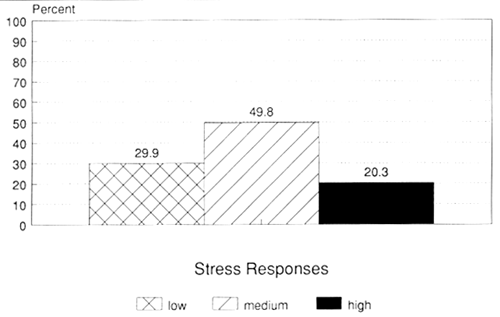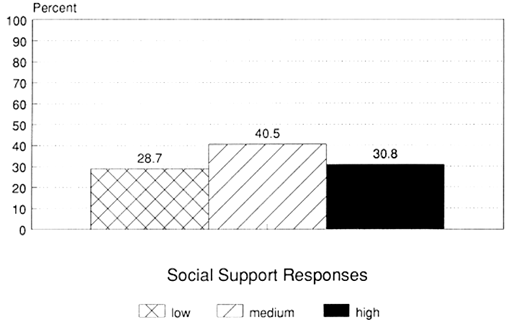Summer 1990 // Volume 28 // Number 2 // Feature Articles // 2FEA2
Targeting Farmers for Stress Reduction
Abstract
The term "farm crisis" is used to describe the negative experiences of farm families in the 1980s that have been described as the worst since the Great Depression of the 1930s. Because the farm crisis places extra demands on farm families (pressure to work longer and harder and the need to work on- and off-farm jobs), concern with farmers' high levels of stress has become a national issue. Some farm families display a diverse set of problems and reactions including social psychological stress, depression, and self-deprecation.
Farm operators are an occupational group vulnerable to uncontrollable and unpredictable demands or stressors - seasonal variations in work requirements, substantial financial investment, and risk.1 Farm income depends on weather, plant and animal disease, changes in domestic government policies, and shifts in international markets. The threat of economic disaster is present in farmers' lives in ways people in other occupations rarely experience. These specific stressors have been exacerbated by economic hardship in the agricultural sector.
Demands inherent in farming as an occupation represent only part of the stress equation. Work of stress theorists suggests that social resources are especially important for decreasing the perceived experience of stress.2 Among farm operators, an important social resource is the support of family, friends, church, and community.
Though farm families are often stereotyped as having well-developed networks of social and community support, recent research shows that the depth of the current farm crisis has severely strained existing social and community support networks.3 It's possible that farm operators and their families are so burdened with problems that they fail to take the time to participate in needed social networks.
Through Extension, many states have developed programs aimed at ameliorating stress by increasing the social network support available to farmers.4 For example, Extension agents in some states (Nebraska, Wisconsin, Illinois, and Iowa) have trained volunteers (who are often members of the rural community themselves) to lead support groups. Other states (Iowa, Kansas, Missouri, North Carolina, Illinois, and Minnesota) have established Rural Concern Hotlines to provide support for distressed farmers and their families. In North Carolina and Missouri, special Extension programs have tried to mobilize the resources of agencies, institutions, and volunteer groups to help alleviate farm family stress.
Does social support help to decrease stress levels among farm operators? The results from a recent study of North Carolina farm operators provide a preliminary answer to this question. In addition, the results help identify the characteristics of farm operators with the highest levels of stress.
North Carolina Study
In January and February of 1987, a random sample of North Carolina farm operators was selected from a list provided by a state agency. Screening questions helped identify current farm operators and 725 were interviewed by telephone on a wide range of topics. Comparisons of demographic data on the 725 farm operators with data from the Census of Agriculture revealed that the sample and population characteristics were similar.
Respondents were asked a series of yes/no questions designed to tap whether they found their lives unpredictable and uncontrollable. Statistical analysis identified the four best items and these were summed into a combined measure of perceived stress (see Table 1). Respondents were also asked six questions about their perceptions of social network support. The responses to these six items were summed into a combined measure of social support (see Table 2). Questions about demographics (age, education, gender, race), household (marital status, household size), farm structure (acres farmed and owned, days on-farm, and off-farm work), and income (total family and percent income from farming) characteristics of the farm operator respondents were also asked.
Table 1. Distribution of stress items.
| Question: "In the last month, have you..." | ||
| Items | Response (n=725) | |
| Yes | No | |
| Been upset because of something that happened unexpectedly? |
27.7% |
72.3% |
| Felt nervous and stressed? | 35.6 | 64.4 |
| Felt that things were going your way? | 70.8 | 29.2 |
| Been angered because of things that were outside of your control? |
46.9 |
53.1 |
Table 2. Distribution of social network support items.
|
Question: "Now considering your own situation, do you feel that you and your family are receiving adequate emotional or financial support from..." |
||
| Sources | Response (N=725) | |
| Yes | No | |
| Family members? | 89.1% | 10.9% |
| Church? | 87.6 | 12.4 |
| Friends and neighbors? | 82.9 | 17.1 |
| Voluntary organizations? | 63.2 | 36.8 |
| Schools? | 54.9 | 45.1 |
| Human service agencies? | 48.3 | 51.7 |
Findings
Though the majority of farm operators gave responses expressing a lack of perceived stress, a substantial minority (ranging from 28% to 47%) indicated they were experiencing some degree of stress (Table 1). The item with the highest distribution of stress responses suggests that almost half of the farm operators had been angered because of uncontrollable events in their lives. For the overall stress index (where high scores represent high stress), the average score for the North Carolina sample was 1.39, the median was 1, and the range was from 0 to 4. About 20% of respondents fell into the high stress range of the overall index, another 50 % fell into the medium range, and 30 % fell into the low range (Figure 1).

Figure 1. Percentage distribution of responses to stress index.
With regards to social support, the North Carolina farm operators indicated there was a hierarchy of sources of perceived support. Responses showed that family members, church, friends, and neighbors were the most important sources of social support, while the perceived support of human service agencies was the least common source of support (Table 2). The overall support index had a mean of 4.3, a median of 5, and a range of 0 to 6 (high scores indicate more social support). About 29% of the respondents scored low, 40% scored medium, and 31% scored high on the overall support index (Figure 2).

Figure 2. Percentage distribution of responses to social support index.
Effects of Social Support on Stress
What's the direct effect of social support on stress? The answer to this question required a multivariate analysis since levels of social support may vary by other factors such as age or education. Our analysis showed that when all other variables were controlled, social support had a significant direct impact on stress. It reduced stress levels, but only for the farm operators 55 years of age or less. This result is puzzling. A study of farm operators in Illinois found that as farm operators aged, they disengaged from participation in social network activities.5 As farm operators age and disengage, the impact of social support may decrease. However, among the North Carolina farm operator sample, the means on the perceived social support index were about equal for both the relatively older and younger groups. Apparently perceived social support has an impact on the stress process in different ways for separate age groups. A study of adults from communities in upstate New York found that the impact of social support on depression was stronger for the group aged 18-49 compared to those 50 and older.6
Which farm operators showed the highest levels of stress in the multivariate analysis? Younger operators, those who worked more days on the farm, those with low or high levels of total family income, those with a lower percentage of income from farming, and those with more concern about their financial future had the highest levels of perceived stress. We interpret these results as showing that farm operator stress among the North Carolina sample is due to both the demands inherent in farming (days on-farm) and to the socioeconomic-based uncertainties of agricultural production (income and financial concern).
Implications for Extension
Many programs designed to help farm operators cope with the stress inherent in farming and that caused by the farm crisis emphasize social support. The results of this study show such attempts may be successful, but only for younger farm operators. Extension practitioners may find their efforts more fruitful if programs are targeted at the age groups of farmers most likely to benefit. For example, programs emphasizing retirement might be particularly important for addressing the financial concerns of older farm operators. For younger operators, intervention programs might focus on augmenting social and personal resources and coping strategies at the personal or family level.7 Farm operators aren't a homogeneous group. The impact of demands and social resources on stress may vary according to age, workload, and income. Extension must take these variations into account in developing programs.
Footnotes
1. K. Olson and R. Schellenberg, "Farm Stressors," American Journal of Community Psychology, XIV (October 1986), 555-69.
2. L. Pearlin and others, "The Stress Process," Journal of Health and Social Behavior, XXII (December 1981), 337-56.
3. W. Heffernan and J. Heffernan, "Sociological Needs of Farmers Facing Severe Economic Problems," in Increasing Understanding of Public Problems and Policies-1986 (Oak Brook, Illinois: Farm Foundation, 1986), pp. 90-102.
4. Extension Service, U.S., Department of Agriculture, Cooperative Extension and Agricultural Profitability-Intensive Assistance for Financially Distressed Farmers, Publication #490- 918/40012 (Washington, D.C.: U.S. Government Printing Office, 1985).
5. K. Heyman and S. Salamon, "Social Status and Social Networks: Examining the Family, Rural Community Interface" (Paper presented at Annual Meetings of the Rural Sociological Society, Athens, Georgia, August 1988).
6. N. Lin, W. Ensel, and A. Dean, "The Age Structure and the Stress Process," in Social Support, Life Events, and Depression, N. Lin, A. Dean, and W. Ensel, eds. (Orlando, Florida: Academic Press, 1986), pp. 213-30.
7. N. Keating, "Reducing Stress of Farm Men and Women," Family Relations, XXXVI (October 1987), 358-63.
